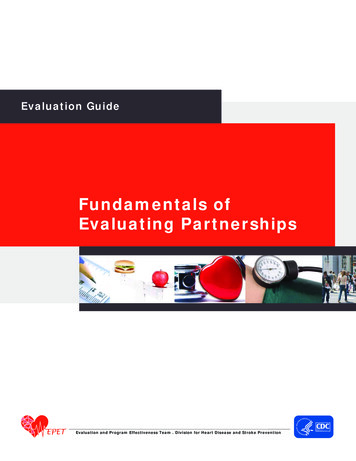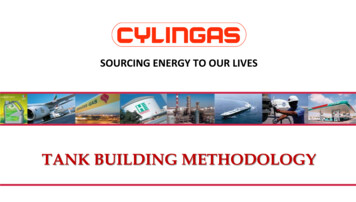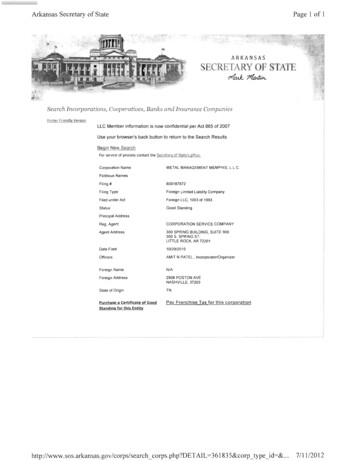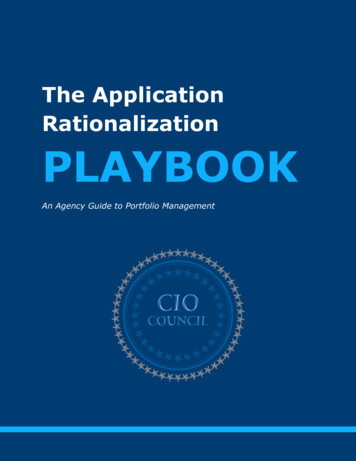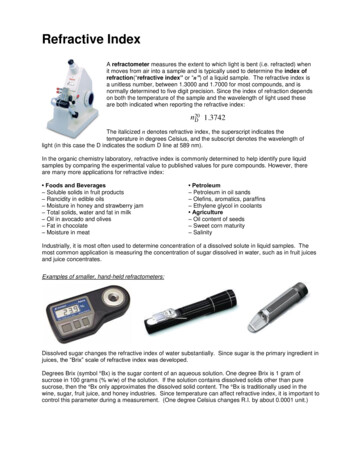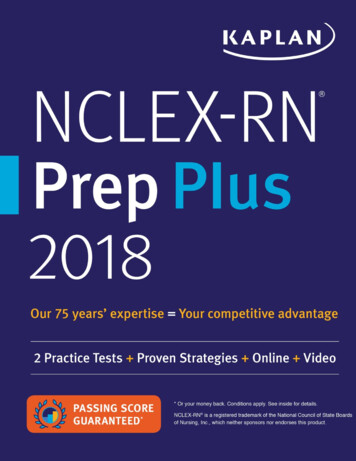
Transcription
Splitting and lumping schemes of theplus-fraction .1137Splitting schemes .Lumping schemes .11381148Problems .1155References .1159APPENDIX . 1165INDEX . 1177
Reservoir Eng FOB2001-10-2916:18Page iSecond Edition
Reservoir Eng FOB2001-10-2916:18Page ii
Reservoir Eng FOB2001-10-2916:18Page iiiSecond EditionGulf Professional PublishingBoston London Auckland Johannesbourg Melbourne New Delhi
Reservoir Eng FOB2001-10-2916:18Page ivGulf Professional Publishing is an imprint of Butterworth-Heinemann.Copyright 2001 by Butterworth-HeinemannA member of the Reed Elsevier groupPreviously copyrighted 2000 by Gulf Publishing Company, Houston, TexasAll rights reserved.No part of this publication may be reproduced, stored in a retrival system, ortransmitted in any form or by any means, electronic, mechanical,photocopying, recording, or otherwise, without the prior written permission ofthe publisher.Recognizing the importance of preserving what has been written,Butterworth-Heinemann prints its books on acid-free paperwhenever possible.Library of Congress Cataloging-in-Publication DataAhmed, Tared H., 1946Reservoir engineering handbook / Tarek Ahmed.p.cm.Includes bibliographical references and index.ISBN 0-88415-770-9 (alk. paper)1. Oil reservoir engineering. 2. Oil fields. 3. Gas reservoirs. I. Title.TN871 .A337 2000622’.3382--dc2199-005377British Library Cataloguing-in-Publication DataA catalogue record for this book is available from the British Library.The publisher offers special discounts on bulk orders of this book. Forinformation, please contact:Manager of Special SalesButterworth-Heinemann225 Wildwood AvenueWoburn, MA 01801–2041Tel: 781-904-2500Fax: 781-904-2620For information on all Butterworth-Heinemann publications available, contactour World Wide Web home page at: http://www.bh.com10 9 8 7 6 5 4 3 2 1Printed in the United States
Reservoir Eng FOB2001-10-2916:18Page vTo my gorgeous wife Shanna,And my beautiful childrenJenniferJustinBrittanyCarsen
ACKNOWLEDGMENTS .xiiiPREFACE TO THE SECOND EDITION .xivPREFACE TO THE FIRST EDITION .xv1 FUNDAMENTALS OF RESERVOIRFLUID BEHAVIOR .1Classification of reservoirs and reservoirfluids .1Pressure-temperature diagram .Oil reservoirs .Gas reservoirs .Undefined petroleum fractions .241024Problems .27References .282 RESERVOIR-FLUID PROPERTIES .29Properties of natural gases .29Behavior of ideal gases .30Behavior of real gases .36Effect of nonhydrocarbon components ofthe Z-factor .44Nonhydrocarbon adjustment methods .The Wichert-Aziz correction method .4545Correction for high-molecular weightgases .49Direct calculation of compressibilityfactors .54Compressibility of natural gases .59Gas formation volume factor .65Gas viscosity .67
Methods of calculating the viscosity ofnatural gases .68Properties of crude oil systems .74Crude oil gravity .Specific gravity of the solution gas .Gas solubility .Bubble-point pressure .Oil formation volume factor .Isothermal compressibility coefficient ofcrude oil .Oil formation volume factor forundersaturated oils .Crude oil density .Crude oil viscosity .7576778692103106108Methods of calculating viscosity of thedead oil .109Methods of calculating the saturated oilviscosity .111Methods of calculating the viscosity ofthe undersaturated oil .112Surface/interfacial tension .115Properties of reservoir water .118Water formation volume factor .Water viscosity .Gas solubility in water .Water isothermal compressibility .118119119120Problems .120References .1263 LABORATORY ANALYSIS OFRESERVOIR FLUIDS .130Composition of the resevoir fluid .13198
Constant-composition expansion tests .131Differential liberation (vaporization) test .143Separator tests .146Adjustment of differential liberation datato separator conditions .151Extrapolation of resevoir fluid data .158Correcting constant-compositionexpansion data .Correcting differential liberation data .Correcting oil viscosity data .Correcting the separator tests data .158160161163Laboratory analysis of gas condensatesystems .165Recombination of separator samples .Constant-composition test .Constant-volume depletion (CVD) test .165168170Problems .178References .1824 FUNDAMENTALS OF ROCKPROPERTIES .183Porosity .184Absolute porosity .Effective porosity .184185Saturation .189Average saturation .191Wettability .193Surface and interfacial tension .194Capillary pressure .197Capillary pressure of reservoir rocks .Capillary hysteresis .200203
Initial saturation distribution in a reservoir .Leverett J-function .Converting laboratory capillary pressuredata .206218Permeability .221The Klinkenberg effect .Averaging absolute permeabilities .228235Weighted-averagepermeability .Harmonic-averagepermeability .Geometric-averagepermeability .221236239243Absolute permeability correlations .244Rock compressibility .248Net pay thickness .254Resevoir heterogeneity .255Vertical Heterogeneity .256Areal heterogeneity .268Problems .273References .2785 RELATIVE PERMEABILITYCONCEPTS .280Two-phase relative permeability .281Drainage process .Imbibition process .Two-phase relatie permeabilitycorrelations .1 Wyllie and Gardner correlation .2 Torcaso and Wyllie correlation .3 Pirson’s correlation .285286286288289289
4 Corey’s method .5 Relative permeability from capillarypressure data .6 Relative permeability from analyticalequations .291Relative permeability ratio .298Dynamic pseudo-relative permeabilities .301Normalization and averaging realtivepermeability data .304Three-phase relative permeability .310Three-phase relative permeabilitycorrelations .Wyllie’s correlations .Stone’s model I .Stone’s model II .The Hustad-Holt correlation .312313314316316Problems .319References .3206 FUNDAMENTALS OF RESERVOIRFLUID FLOW .321Types of fluid .322Flow regimes .324Resevoir geometry .326Number of flowing fluids in the resevoir .329Fluid flow equations .330Darcy’s Law .331Steady-state flow .332Linear flow of incompressible fluids .Linear flow of slightly compressible fluids .Linear flow of compressible fluids (gases) .333339341292294
Radial flow of incompressible fluids .Radial flow of slightly compressible fluids .Radial flow of compressible gases .Horizontal multiple-phase flow .344350352360Unsteady-state flow .363Basic transient flow equation .Radial flow of slightly compressible fluids .365370Constant-terminal-pressure solution .374Constant-terminal-rate solution .374The E-function solution .The dimensionless pressure drop (Pd)solution .Radial flow of compressible fluids .The m(p)-solution method(exact-solution) .The pressure-squared approximationmethod (p2-method) .The pressure-approximation method .375Pseudosteady-state flow .403Radial flow of slightly compressible fluids .Radial flow of compressible fluids(gases) .Pressure-squared approximation method .Pressure-approximation method .Skin factor .Turbulent flow factor .409Principle of superposition .431Effects of multiple wells .Effects of variable flow rates .Effects of the reservoir boundary .Accounting for pressure-change effects .432435438442Transient well testing .442Drawdown test .443383392395398400418419419420426
Pressure buildup test .456Problems .465References .4717 OIL WELL PERFORMANCE .473Vertical oil well performance .473Productivity index and IPR .Vogel’s method .Saturated oil reservoirs .Undersaturated oil reservoirs .Wiggins’ method .Standing’s method .Fetkovich’s method .The Klins-Clark method .473482483485491494498514Horizontal oil well performance .515Method I .Method II .Horizontal well productivity understeady-state flow .Borisov’s method .The Giger-Reiss-Jourdan method .Joshi’s method .The Renard-Dupuy method .Horizontal well productivity undersemisteady-state flow .516517Problems .529References .5318 GAS WELL PERFORMANCE .533Vertical gas well performance .533Region I. High-pressure region .Region II. Intermediate-pressure region .536537519520520521522527
Region III. Low-pressure region .The simpified treatment approach .The Laminar-Inertial-Turbulent (LIT)approach .The Back-Pressure test .Future inflow performance relationships .537543Horizontal gas well performance .562Problems .566References .5689 GAS AND WATER CONING .569Coning .570Coning in vertical wells .573Vertical well critical rate correlations .573The Meyer-Gardercorrelation .The Chierici-Ciucci approach .TheHoyland-Papatzacos-Skjaevemethods.Critical rate curves byChaney et al. .Chaperson’s method .Schols’ method .545550559574581593597604605Breakthrough time in vertical wells .606The Sobocinski-Cornelius method .The Bournazel-Jeanson method .606609After breakthrough performance .610Coning in horizontal wells .615Horizontal well critical rate correlations .616Chaperson’s method .Efros’ method .616620
Karcher’s method .Joshi’s method .621622Horizontal well breakthrough time .624The Ozkan-Raghavan method .Papatzacos’ method .624627Problems .632References .63410 WATER INFLUX .636Classification of aquifers .637Degree of pressure maintenance .Outer boundary conditions .Flow regimes .Flow geometries .637639639639Recognition of natural water influx .640Water influx models .641The pot aquifer model .Schilthuis’ steady-state model .Hurst’s modified steady-state model .The Van Everdingen-Hurstunsteady-state model .642645649The edge-water drive .Bottom-water drive .654677The Carter-Tracey water influx model .Fetkovich’s method .703707Problems .713References .71611 OIL RECOVERY MECHANISMSAND THE MATERIAL BALANCEEQUATION .717Primary recovery mechanisms .718653
Rock and liquid expansion .The depletion drive mechanism .Gas cap drive .The water-drive mechanism .The gravity-drainage-drive mechanism .The combination-drive mechanism .718719721726730735The material balance equation .736Basic assumptions in the MBE .The MBE as an equation of a straight line .The straight-line solution method to theMBE .Case 1. Volumetric undersaturated-oilresevoirs .Case 2. Volumetric saturated-oilreservoirs .Case 3. Gas-cap-drive reservoirs .Case 4. Water-drive reservoirs .751753The pot-aquifer model in theMBE .The steady-state model inthe MBE.The unsteady-state model inthe MBE.755755760762766768769770Tracy’s form of the material balanceequation .774Problems .778References .78112 PREDICTING OIL RESERVOIRPERFORMANCE .782Phase 1. Reservoir performanceprediction methods .783Instantaneous gas-oil ratio .The resevoir saturation equations .783789
Undersaturated-oil reservoirs .Saturated-oil reservoirs .Tracy’s method .Muskat’s method .Tarner’s method .797801803810815Phase 2. Relating reservoir performanceto time .822Problems .825References .82613 GAS RESERVOIRS .827The volumetric method .828The material balance method .831Volumetric gas reservoirs .Form 1. In terms of p/z .Form 2. In terms of Bg .Water-drive gas reservoirs .832833838840Material balance equation as a straightline .842Abnormally pressured gas reservoirs .847Effect on gas production rate on ultimaterecovery .853Problems .854References .85614 PRINCIPLES OF WATERFLOODING .857Factors to consider in waterflooding .858Reservoir geometry .Fluid properties .Reservoir depth .Lithology and rock properties .Fluid saturations .859859859860861
Reservoir uniformity and pay continuity .Primary reservoir driving mechanisms .861861Optimum time to waterflood .863Effect of trapped gas on waterfloodrecovery .865First theory .Second theory .865866Selection of flooding patterns .875Irregular injection patterns .Irregular injection patterns .Peripheral injection patterns .Regular injection patterns .Crestal and basal injection patterns .875875876878879Overall recovery efficiency .880I. Displacement efficiency .881II. Areal sweep efficiency .932III. Vertical sweep efficiency .989Calculation of vertical sweep efficiency .997Methods of predicting recoveryperformance for layered reservoirs .1006Simplified Dykstra-Parsons method .Modified Dykstra-Parsons method .Craig-Geffen-Morse method .100610101013Problems .1016References .102415 VAPOR-LIQUID PHASEEQUILIBRIA . 1026Vapor pressure .1026Equilibrium ratios .1029Flash calculations .1033
Equilibrium ratios for real solutions .1037Wilson’s correlation .Standing’s correlation .Convergence pressure method .Whitson and Torp correlation .1038103810431049Equilibrium ratios for the plus fraction .1050Campbell’s method .Winn’s method .Katz’s method .105110511052Applications of the equilibrium ratio inreservoir engineering .1052Dew-point pressure .Bubble-point pressure .Separator calculations .Density calculations .1053105510581072Equations of state .1084The Van der Waals equation of state .Redlick-Kwong equation of state .Soave-Redlick-Kwong equation of stateand its modifications .Modifications of the SRK EOS .Peng-Robinson equation of state and itsmodifications .10841092Applications of the equation of state inpetroleum engineering .Determination of the equilibrium ratios .Determination of the dew-point pressure .Determination of the bubble-pointpressure .Three-phase equilibrium calculations .Vapor pressure from equilibrium of state .109811081112112411241125112811291135
Reservoir Eng FOB2001-10-2916:18Page xiiiACKNOWLEDGMENTSMuch of the material on which this book is based was drawn from thepublications of the Society of Petroleum Engineers. Tribute is due to theSPE and the petroleum engineers, scientists, and authors who have madenumerous and significant contributions to the field of reservoir engineering. I would like to express my appreciation to a large number of my colleagues within the petroleum industry and academia who offered suggestions and critiques on the first edition; special thanks go to Dr. WenxiaZhang with TotalFinaElf E&P USA, Inc, for her suggestions and encouragements. I am also indebted to my students at Montana Tech of the University of Montana, whose enthusiasm has made teaching a pleasure; Ithink! Special thanks to my colleagues and friends: Dr. Gil Cady, Professor John Evans; and Dr. Margaret Ziaja for making valuable suggestionsfor the improvement of this book. I would like to acknowledge andexpress my appreciation to Gary Kolstad, Vice President and GeneralManager with Schlumberger, and Darrell McKenna, Vice President withSchlumberger; for their continued support.I would like to thank the editorial staff of Butterworth-Heinemann andGulf Professional Publishing for their concise and thorough work. Igreatly appreciate the assistance that Karen Forster has given me duringmy work on the second edition.xiii
Reservoir Eng FOB2001-10-2916:18Page xivPREFACE TO THESECOND EDITIONI have attempted to construct the chapters following a sequence that Ihave used for several years in teaching three undergraduate courses inreservoir engineering. Two new chapters have been included in this second edition; Chapter 14 and 15. Chapter 14 reviews principles of waterflooding with emphasis on the design of a waterflooding project. Chapter15 is intended to introduce and document the practical applications ofequations of state in the area of vapor-liquid phase equilibria. A comprehensive review of different equations of state is presented with anemphasis on the Peng-Robinson equation of state.xiv
Reservoir Eng FOB2001-10-2916:18Page xvPREFACE TO THEFIRST EDITIONThis book explains the fundamentals of reservoir engineering and theirpractical application in conducting a comprehensive field study. Chapter1 reviews fundamentals of reservoir fluid behavior with an emphasis onthe classification of reservoir and reservoir fluids. Chapter 2 documentsreservoir-fluid properties, while Chapter 3 presents a comprehensivetreatment and description of the routine and specialized PVT laboratorytests. The fundamentals of rock properties are discussed in Chapter 4 andnumerous methodologies for generating those properties are reviewed.Chapter 5 focuses on presenting the concept of relative permeability andits applications in fluid flow calculations.The fundamental mathematical expressions that are used to describethe reservoir fluid flow behavior in porous media are discussed in Chapter 6, while Chapters 7 and 8 describe the principle of oil and gas wellperformance calculations, respectively. Chapter 9 provides the theoreticalanalysis of coning and outlines many of the practical solutions for calculating water and gas coning behavior. Various water influx calculationmodels are shown in Chapter 10, along with detailed descriptions of thecomputational steps involved in applying these models. The objective ofChapter 11 is to introduce the basic principle of oil recovery mechanismsand to present the generalized form of the material balance equation.Chapters 12 and 13 focus on illustrating the practical applications of thematerial balance equation in oil and gas reservoirs.xv
Reservoir Eng FOB2001-10-2916:18Page xvixvi
Reservoir Eng Hndbk Ch 01 2001-10-24 09:04 Page 1CHAPTER1FUNDAMENTALS OFRESERVOIR FLUIDBEHAVIORNaturally occurring hydrocarbon systems found in petroleum reservoirs are mixtures of organic compounds which exhibit multiphasebehavior over wide ranges of pressures and temperatures. These hydrocarbon accumulations may occur in the gaseous state, the liquid state, thesolid state, or in various combinations of gas, liquid, and solid.These differences in phase behavior, coupled with the physical properties of reservoir rock that determine the relative ease with which gas andliquid are transmitted or retained, result in many diverse types of hydrocarbon reservoirs with complex behaviors. Frequently, petroleum engineers have the task to study the behavior and characteristics of a petroleum reservoir and to determine the course of future development andproduction that would maximize the profit.The objective of this chapter is to review the basic principles of reservoir fluid phase behavior and illustrate the use of phase diagrams in classifying types of reservoirs and the native hydrocarbon systems.CLASSIFICATION OF RESERVOIRSAND RESERVOIR FLUIDSPetroleum reservoirs are broadly classified as oil or gas reservoirs.These broad classifications are further subdivided depending on:1
Reservoir Eng Hndbk Ch 01 2001-10-24 09:04 Page 22Reservoir Engineering Handbook The composition of the reservoir hydrocarbon mixture Initial reservoir pressure and temperature Pressure and temperature of the surface productionThe conditions under which these phases exist are a matter of considerable practical importance. The experimental or the mathematical determinations of these conditions are conveniently expressed in differenttypes of diagrams commonly called phase diagrams. One such diagramis called the pressure-temperature diagram.Pressure-Temperature DiagramFigure 1-1 shows a typical pressure-temperature diagram of a multicomponent system with a specific overall composition. Although a different hydrocarbon system would have a different phase diagram, thegeneral configuration is similar.Critical PoiECBu100%Two-phase ointCurveLiquidF5% 0%BTemperatureFigure 1-1. Typical p-T diagram for a multicomponent system.Gas
Reservoir Eng Hndbk Ch 01 2001-10-24 09:04 Page 3Fundamentals of Reservoir Fluid Behavior3These multicomponent pressure-temperature diagrams are essentiallyused to: Classify reservoirs Classify the naturally occurring hydrocarbon systems Describe the phase behavior of the reservoir fluidTo fully understand the significance of the pressure-temperature diagr
Gulf Professional Publishing Boston London Auckland Johannesbourg Melbourne New Delhi Second Edi





